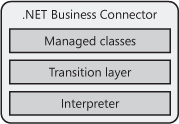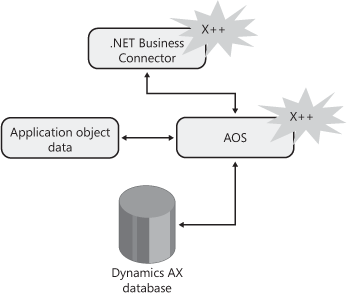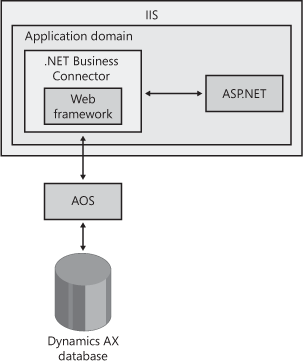.NET Business Connector is a
versatile platform component. It contains the Dynamics AX kernel and
provides a runtime environment for executing X++ code and interacting
with other elements in the AOT. Nearly the entire Dynamics AX
development and runtime environment is based on X++, and the kernel is
responsible for interpreting and executing this code, part of the reason
.NET Business Connector is so powerful.
1. Logical Component Stack
In .NET Business Connector, the following three logical components (illustrated in Figure 1) interoperate to deliver functionality:

Managed Classes
The
managed classes component is a set of .NET Framework–based classes that
expose the functionality you can access through .NET Business
Connector. It includes the following classes: Axapta, AxaptaBuffer, AxaptaContainer, AxaptaObject, and AxaptaRecord. The functionality of the managed classes is mostly equivalent to the
COM Business Connector, which will be discontinued in future versions of
Dynamics AX.
Transition Layer
In the transition layer, .NET Framework objects
and types are mapped to their Dynamics AX equivalents. This mapping
occurs as part of both the request and the response processing in .NET
Business Connector.
Interpreter
The interpreter is the part of the Dynamics AX
kernel that is responsible for parsing and executing X++ code. Dynamics
AX allows code to be executed locally in the kernel of .NET Business
Connector or remotely in the kernel of the AOS. The interpreter manages
local and remote code execution. It also manages connectivity to the AOS
and other infrastructure, such as session management and security.
2. Run Time
At run time, .NET Business Connector interacts with the AOS. Figure 2 depicts the run-time interaction.

The following list describes the important interactions among .NET Business Connector, the AOS, and the Dynamics AX database:
.NET Business Connector authenticates against the AOS when the Axapta.Logon
method is called. The credentials that .NET Business Connector passes
to the AOS must correspond to an existing Dynamics AX user, who must be
enabled and have the appropriate rights, granted through security keys,
to use .NET Business Connector.
The AOS completes the authentication and establishes a session for the Dynamics AX user.
Other
.NET Business Connector classes and methods are invoked as needed. Once
the session is established, .NET Business Connector can be used to
create, read, update, or delete (CRUD) Dynamics AX data. In addition,
the X++ business logic that resides in the Dynamics AX metadata store,
the application object data can be invoked and executed either on the
AOS or in .NET Business Connector.
3. Web Interoperability
The Dynamics AX development environment includes a Web framework, the Enterprise Portal framework. This framework is used to develop the Web-based
functionality in X++, which is then exposed in Enterprise Portal.
Enterprise Portal uses .NET Business Connector to integrate with
Dynamics AX, and .NET Business Connector can interoperate with Microsoft
Internet Information Services (IIS) and Microsoft ASP.NET to provide
access to the HTTP context information, including requests, responses,
and view state, necessary to enable Web-based functionality.
Figure 3 illustrates how Web interoperability works.

Managed Web applications, including Enterprise
Portal, execute in IIS within an application domain. Upon
initialization, the application domain loads and instantiates .NET
Business Connector. The managed application then uses .NET Business
Connector to invoke Dynamics AX Web framework elements, such as Web menu
items, Web forms, and Web reports. The X++ code stored in the
application object data that defines these elements accesses the HTTP
context as needed through the following classes (located in the AOT
under System Documentation\Classes):
IISApplicationObject
IISContextObject
IISPostedFile
IISReadCookie
IISRequest
IISRequestDictionary
IISResponse
IISServer
IISSessionObject
IISStringList
IISVariantDictionary
IISViewState
IISWriteCookie
For example, you could write an X++ class to
retrieve a variable from the HTTP context, which you could then use in
another X++ class. In the following code example, the method takes a
parameter, which is the name of the HTTP context variable, the value of
which is obtained using IISRequest.
str getIISServerVariable(str 80 var)
{
IISRequest request;
str res;
;
request = new IISRequest();
res = request.serverVariables().itemTxt(var);
return res;
}
|
If you want to develop a new, custom Web-enabled
application that integrates with Dynamics AX and can access managed
HTTP context information, you can use both ASP.NET and .NET Business
Connector. The interoperability among IIS, ASP.NET, and .NET Business
Connector allows you to access HTTP context information from X++ code
that is part of your application.
Note
To
successfully run with Dynamics AX 2009, existing applications developed
with the previous version of the COM Business Connector and ASP that
accessed the unmanaged HTTP context must be migrated to ASP.NET. |
4. Security
This section highlights the security mechanisms
in place for .NET Business Connector and covers authentication,
authorization (including security keys), and code access security.
Authentication
Integrated Windows authentication is
implemented throughout Dynamics AX 2009, including .NET Business
Connector. The managed classes use parameters that are specific to
Integrated Windows authentication.
Authorization
.NET
Business Connector has an associated set of Dynamics AX security keys
that control access to different parts of its functionality. Table 1 describes these security keys. You can find more information about these keys in the Data Dictionary under Security Keys.
Table 1. Dynamics AX Security Keys
| Security Key | Description |
|---|
| SysCom | Enables or disables the use of COM Business Connector and .NET Business Connector |
| SysComData | Controls the user’s level of access to data |
| SysComExecution | Controls access to execution rights of classes and jobs in .NET Business Connector |
| SysComIIS | Controls whether .NET Business Connector is accessible to users when it’s running in the context of IIS |
You can create sessions in .NET Business
Connector either directly or indirectly. The direct approach uses the
credentials of the current Dynamics AX user. The indirect approach uses
the proxy impersonation mechanism whereby an AX user can be impersonated
using the LogonAs API. You can control
the use of .NET Business Connector in different user groups in Dynamics
AX by configuring these security keys. If you do configure these
security keys, they will apply only in sessions created directly.
Code Access Security
Code access security (CAS) was introduced in
Dynamics AX 4.0. CAS is a mechanism intended to help Dynamics AX
developers write code that invokes protected X++ APIs in a manner that
minimizes the potential for them to be maliciously exploited. A
protected API is an X++ API method that has been secured by using CAS.
CAS also ensures that the protected APIs are executed only on the AOS,
not on the Dynamics AX client or .NET Business Connector. CAS therefore
restricts the X++ APIs that can be executed locally in .NET Business
Connector. If an attempt to use a restricted API is made, a CAS
exception is returned.